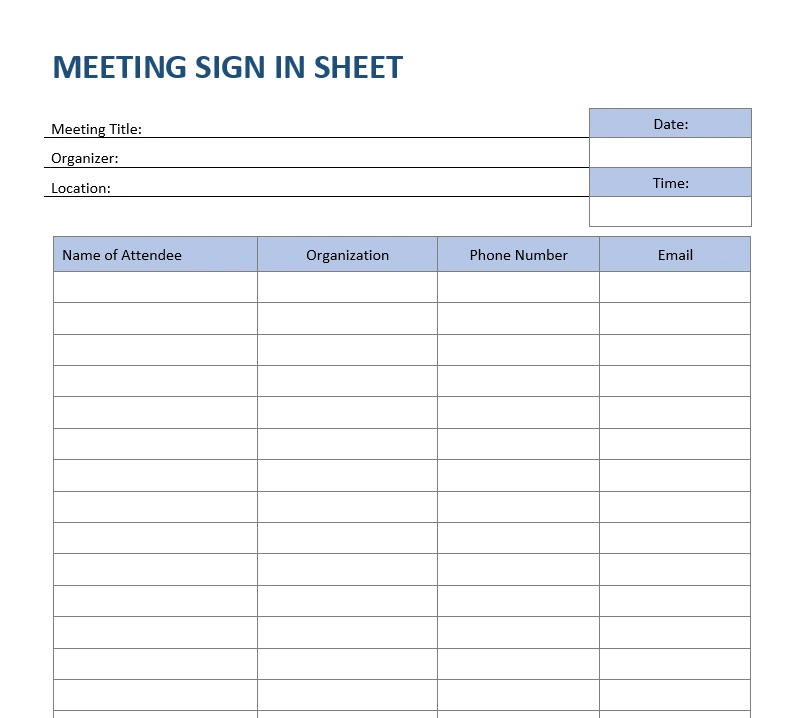
What is a Meeting Sign-In Sheet?
A meeting sign-in sheet is a simple but powerful tool used to record the attendance of individuals at a meeting or event. It typically consists of fields for participants to fill out their name, title or affiliation, contact information, and signature.
This document serves as a tangible record of who was present at the meeting, providing a snapshot of the attendees for future reference.
Benefits of Keeping a Meeting Sign-In Sheet
One of the primary benefits of using a meeting sign-in sheet is the ability to track attendance accurately. It helps organizers ensure that all expected participants have shown up and allows them to identify any missing individuals promptly. The sheet also serves as a form of documentation that can be referenced later for various purposes, such as compliance, accountability, and follow-up.
Moreover, a meeting sign-in sheet can be essential for maintaining legal and safety requirements. In some industries or organizations, it is mandatory to keep records of who attends specific meetings for regulatory purposes. Having a sign-in sheet can provide proof of participation and help demonstrate compliance with relevant guidelines.
Additionally, the sign-in sheet can facilitate communication and follow-up with attendees after the meeting. By collecting contact information from participants, organizers can easily reach out to them for feedback, updates, or future event invitations. This fosters a sense of engagement and connection among attendees, enhancing the overall meeting experience.
Elements of a Well-Designed Meeting Sign-In Sheet
When creating a meeting sign-in sheet, it’s important to include certain key elements to ensure its effectiveness. These elements help streamline the sign-in process, capture essential information accurately, and maintain the integrity of the attendance record.
First and foremost, the sign-in sheet should clearly state the name of the meeting or event and the date on which it took place. This information helps differentiate the sheet from others and provides context for the attendance record. Including a section for participants to write their names is essential, as it serves as the primary identifier for each attendee.
Additionally, having fields for participants to input their title or affiliation can be beneficial, especially in larger meetings or events where individuals may not be familiar with everyone in attendance. This information helps create a more detailed picture of the participants and their roles within the organization or group.
Another crucial element of a meeting sign-in sheet is the contact information field. Collecting email addresses or phone numbers from attendees allows organizers to follow up with them after the meeting, share relevant materials or updates, and maintain a line of communication for future engagements.
Finally, including a signature field on the sign-in sheet is essential for verifying attendance and ensuring accountability. Participants can sign next to their name, indicating that they were present at the meeting and acknowledging their commitment to the event. This signature serves as a form of confirmation and can be useful for any potential disputes or discrepancies regarding attendance.
Effective Strategies for Using a Meeting Sign-In Sheet
To maximize the benefits of a meeting sign-in sheet, organizers can implement several strategies to ensure its effectiveness and efficiency. These strategies help streamline the sign-in process, improve data accuracy, and enhance the overall attendee experience.
One effective strategy is to design a clear and user-friendly sign-in sheet that is easy for participants to fill out. Avoid cluttering the sheet with unnecessary information or complex formatting, as this can confuse attendees and lead to errors in data entry. Keep the design simple and intuitive to encourage swift completion.
Another strategy is to provide clear instructions for participants on how to fill out the sign-in sheet. Include brief guidelines or examples near the top of the sheet to help attendees understand what information is required and how to input it correctly. This reduces confusion and ensures that all necessary details are captured accurately.
Organizers can also designate a specific individual or team to oversee the sign-in process and address any issues that may arise. Having a dedicated staff member or volunteer manage the sign-in sheet can help streamline the process, troubleshoot any technical difficulties, and ensure that all attendees are accounted for.
Furthermore, it’s essential to store completed sign-in sheets securely and maintain them for future reference. Organizers should establish a systematic filing system or digital storage solution to organize and archive the attendance records effectively. This ensures that the information is easily accessible when needed and can be used for various reporting or analysis purposes.
Tips for Enhancing the Effectiveness of Meeting Sign-In Sheets
There are several tips and best practices that organizers can follow to enhance the effectiveness of their meeting sign-in sheets and maximize their utility. These tips help improve data accuracy, streamline the sign-in process, and optimize the overall attendee experience.
- Keep the sign-in sheet concise: Avoid including unnecessary fields or information on the sheet that could confuse participants or lead to errors in data entry.
- Use legible fonts and formatting: Ensure that the text on the sign-in sheet is easy to read and that the formatting is clear and consistent throughout the document.
- Provide pens or writing utensils: Make sure that participants have access to pens or pencils to fill out the sign-in sheet easily, especially for in-person meetings.
- Implement a digital sign-in process: Consider using electronic sign-in solutions or apps to streamline the sign-in process and reduce paper waste for virtual or hybrid meetings.
- Regularly review and update the sign-in sheet: Periodically review the design and layout of the sign-in sheet to ensure it remains relevant and meets the needs of the attendees and organizers.
By following these tips and incorporating best practices into the design and implementation of meeting sign-in sheets, organizers can create a more organized, efficient, and engaging meeting experience for all participants. Sign-in sheets serve as valuable tools for tracking attendance, ensuring compliance, and fostering communication among attendees, making them essential components of successful meetings and events.
Meeting Sign-in Sheet Template – DOWNLOAD